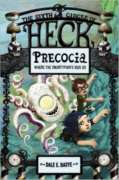
Following sentencing in the court of Judge Judas, eleven-year-old Milton and his older sister Marlo find themselves in Precocia, the circle of Heck for kids that grow up too fast.
Materials from United States of America

Following sentencing in the court of Judge Judas, eleven-year-old Milton and his older sister Marlo find themselves in Precocia, the circle of Heck for kids that grow up too fast.
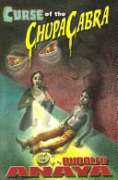
Professor Rosa Medina, a folklorist researching the ChupaCabra, goes to Mexico to track down recent sightings of the creature which kills its victims, particularly goats, by sucking their brains out.
 Angie is broken–by her can’t-be-bothered mother, by her high-school tormentors, and by being the only one who thinks her varsity-athlete-turned-war-hero sister is still alive. Hiding under a mountain of junk food hasn’t kept the pain (or the shouts of “crazy mad cow!”) away. Having failed to kill herself–in front of a gym full of kids–she’s back at high school just trying to make it through each day. That is, until the arrival of KC Romance, the kind of girl who doesn’t exist in Dryfalls, Ohio. A girl who is one hundred and ninety-nine percent wow! A girl who never sees her as Fat Angie, and who knows too well that the package doesn’t always match what’s inside. With an offbeat sensibility, mean girls to rival a horror classic, and characters both outrageous and touching, this darkly comic anti-romantic romance will appeal to anyone who likes entertaining and meaningful fiction.
Angie is broken–by her can’t-be-bothered mother, by her high-school tormentors, and by being the only one who thinks her varsity-athlete-turned-war-hero sister is still alive. Hiding under a mountain of junk food hasn’t kept the pain (or the shouts of “crazy mad cow!”) away. Having failed to kill herself–in front of a gym full of kids–she’s back at high school just trying to make it through each day. That is, until the arrival of KC Romance, the kind of girl who doesn’t exist in Dryfalls, Ohio. A girl who is one hundred and ninety-nine percent wow! A girl who never sees her as Fat Angie, and who knows too well that the package doesn’t always match what’s inside. With an offbeat sensibility, mean girls to rival a horror classic, and characters both outrageous and touching, this darkly comic anti-romantic romance will appeal to anyone who likes entertaining and meaningful fiction.
“Jude has learned a lot from her older sisters, but the most important thing is this: The Vargas brothers are notorious heartbreakers. But as Jude begins to fall for Emilio Vargas, she begins to wonder if her sisters were wrong”–

Placed under a temporary retstraining order for torching her former boyfriend’s car, seventeen-year-old Rosie embarks on a cross-country car trip from New Jersey to Arizona while waiting for her court appearance.
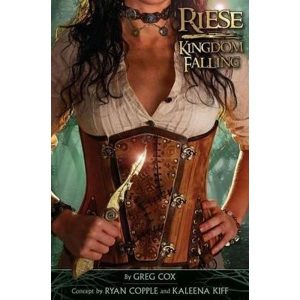 Riese has never been happy as a princess; she’d much rather be hunting or fighting than sitting through another lesson on court etiquette. When she meets Micah, a wandering artist with a mysterious past, she pretends to be a peasant–it’s a chance to be just a normal girl with a normal boy for a while. But with war decimating her once-proud nation and the sinister clockwork Sect infiltrating her mother’s court, Riese’s moments with Micah are the only islands of sanity left in a world gone mad. As her kingdom falls and the Sect grows ever stronger, will Riese remain true to her duty as a princess…or risk everything on a boy she barely knows?
Riese has never been happy as a princess; she’d much rather be hunting or fighting than sitting through another lesson on court etiquette. When she meets Micah, a wandering artist with a mysterious past, she pretends to be a peasant–it’s a chance to be just a normal girl with a normal boy for a while. But with war decimating her once-proud nation and the sinister clockwork Sect infiltrating her mother’s court, Riese’s moments with Micah are the only islands of sanity left in a world gone mad. As her kingdom falls and the Sect grows ever stronger, will Riese remain true to her duty as a princess…or risk everything on a boy she barely knows?
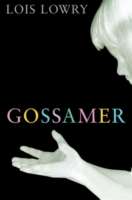
While learning to bestow dreams, a young dream giver tries to save an eight-year-old boy from the effects of both his abusive past and the nightmares inflicted on him by the frightening Sinisteeds.
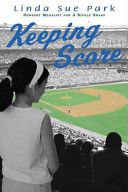
In Brooklyn in 1951, a die-hard Giants fan teaches nine-year-old Maggie, who is a “Bums” (Dodgers) fan, how to keep score which creates a special friendship between them.
See the review at WOW Review, Volume 5, Issue 3.

How a young boy is raised by his grandfather on the Tohono O’odham Indian Reservation. The book denotes various aspects of O’odham himdag (culture) and begins with a simple question that the boy asks his Hu’ul Ke:li (Grandfather) with a culturally relevant answer as to why they do the things they do during the day. Various activities include waking up early in the morning and asking why they do so – to daily chores and activities such as tending horses, working in the garden, hauling water, and gathering food/medicine in the desert.

This coloring book includes an introduction/information page with a map of Arizona highlighting the O’odham speaking Nations. A pronunciation page is next followed by the coloring pages. The coloring book is written in the Alvarez-Hale orthography (alphabet). Each page highlights one of the twenty-four letters of the O’odham alphabet. Each letter has three line art drawings to color along with the O’odham vocabulary word under each of them.